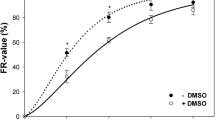Background:
4-Hydroxyifosfamide is the primary metabolite in vivo of the bifunctional alkylating cytostatic ifosfamide. DNA interstrand cross-linking induced by bifunctional alkylators may be repaired through an intermediate with unligated repair patches on both strands which should uncover analytically as DNA double-strand breaks and allow to measure the rejoining kinetic of this repair intermediate. Additionally, the combined effects of drug and radiation treatment on rejoining of double-strand breaks was investigated with two different mammalian cell lines.
Material and Methods: V79 (rodent fibroblasts) and Widr (human colon carcinoma) cells were treated for 2 hours with 4-hydroperoxyifosfamide which rapidly decays to 4-hydroxyifosfamide in aqueous solution or were exposed in combination with ionizing radiation followed by incubation for repair with or without the drug. DNA double-strand breakage was measured by pulsed-field electrophoresis.
Results: The 2 hours 4-hydroperoxyifosfamide treatment (30 μg/ml) resulted in a pronounced DNA fragmentation that, 2–4 hours after drug removal, declined with an estimated half-live of about 4 hours for both cell lines. When the cells were additionally irradiated with 10 Gy given in the middle of drug exposure, the residual fragmentation after 12 or 24 hours incubation for repair was only marginally increased, roughly corresponding to the respective value after radiation, alone. A continuous drug exposure of 6 hours (at 10 μg/ml) resulted in a fragementation that was independent of a preirradiation with a high dose of 30 Gy, immediately bevor drug addition.
Conclusions: The present data support the idea that unligated/unrejoined double-stranded DNA ends are generated during the repair of lesions from bifunctional alkylators. The rate of subsequent rejoining is in the order of magnitude of the slow rejoining of radiation-induced double-strand breaks. Processing of double-stranded DNA damage from either 4-hydroperoxyifosfamid or radiation exposure is apparently unaffected in combined treatments.
Hintergrund:
4-Hydroxyifosfamid ist der primäre, in vivo aktive Metabolit des bifunktionalen Zytostatkiums Ifosfamid. Durch bifunktionale Alkylanzien hervorgerufene DNA-DNA-Vernetzungen (Crosslinks) scheinen mittels Intermediaten mit unligierten DNA-Reparaturstücken auf beiden DNA-Strängen prozessiert zu weden. Dies erlaubt deren Erfassung als DNA-Doppelstrangbrüche sowie die Möglichkeit, ihre Reparaturkinetik zu messen. Zusätzlich wurden die kombinierten Effekte des Alkylanz und ionisierender Strahlung auf DNA-Rejoining in zwei Säugetierzelllinien bestimmt.
Material und Methoden: V79-(Hamsterfibroblasten) und Widr-Zellen (humanes Kolonkarzinom) wurden 2 Stunden mit 4-Hydroperoxyifosfamid, das in wässriger Lösung schnell in 4-Hydroxyifosfamid zerfällt, behandelt. Ferner erfolgte auch eine kombinierte Behandlung mit ionisierenden Strahlen, gefolgt von einer Reparaturinkubation mit und one der Substanz. Die resultierenden DNA-Doppelstrangbrüche wurden mittels Pulsfeldgelelektrophorese gemessen.
Ergebnisse: Die 2-stündige Behandlung mit 4-Hydroperoxyifosfamid (30 μg/ml) resultierte in einer erhöhten Fragmentierung, die 2–4 Stunden nach Entfernung der Substanz in beiden Zelllinien mit einer geschätzten Halbwertszeit von etwa 4 Stunden abnahm. Bei zusätzlicher Bestrahlung mit 10 Gy in der Mitte der Drogenexposition zeigte sich eine residuale Fragmentierung nach 12 oder 24 Stunden Reparaturinkubation, die nur noch marginal erhöht war. Diese residuale Fragmentierung entsprach im Prinzip einer solchen nach alleiniger Bestrahlung. Eine kontinuierliche Exposition über 6 Stunden mit 4-Hydroperoxyifosfamid (10 μg/ml) ergab eine Fragmentierung, die unabhängig von einer zusätzlichen Bestrahlung mit 30 Gy unmittelbar zu Beginn der Drogenbehandlung war.
Schlussfolgerungen: Die vorliegenden Daten unterstützen die Vorstellung, dass unligierte/nicht rejointe DNA-Doppelstrangbruchenden während der Reparatur von Schäden durch bifunktionale Alkylanzien generiert werden. Die Rejoining-Rate dieser Schäden liegt in der Größenordnung der langsamen Reparatur von strahleninduzierten Doppelstrangbrüchen. Die Prozessierung von DNA-Doppelstrangbruchschäden durch 4-Hydroperoxyifosfamid und ionisierenden Strahlen scheint bei kombinierter Anwendung unabhängig voneinander zu erfolgen.
Similar content being viewed by others
Author information
Authors and Affiliations
Additional information
Received: August 16, 2001; accepted: January 22, 2002
Rights and permissions
About this article
Cite this article
Latz, D., Weber, KJ. Transient DNA Double-Strand Breakage in 4-Hydroperoxyifosfamide-Treated Mammalian Cells in Vitro Does Not Interact with the Rejoining of Radiation-Induced Double-Strand Breaks. Strahlenther Onkol 178, 269–274 (2002). https://doi.org/10.1007/s00066-002-0929-4
Issue Date:
DOI: https://doi.org/10.1007/s00066-002-0929-4




